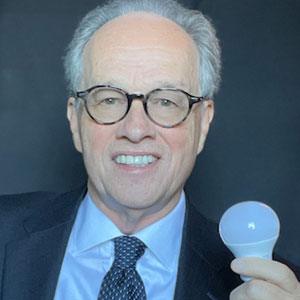In his June “Forces of Change” column for LD+A, Mark Lien examines how a business book that never mentions lighting speaks directly to the challenges that our industry is facing. An excerpt follows here:
Peter Diamandis and Steven Kotler, authors of Bold are futurists. Diamandis is a co-founder of Singularity University with Ray Kurzweil, chief technology officer for Google. Bold weaves examples from various industries including computers, publishing, photography and more to reveal commonalities that form a sequential six-stage process the authors call “The 6 Ds – The Hallmarks of Exponential Growth.”
- The first stage is when the industry goes digital. Turning things into zeros and ones makes them simpler, cheaper and quicker to reproduce and distribute. The electronics industry has been going through Digitalization for over 50 years. Lighting is the last major industry to be based on vacuum tubes. We have been transitioning to digital, solid-state sources for just the past decade.
- Once a new technology is publicized, expectations are elevated. There is glowing speculation about amazing possibilities. One example was the computer. It promised to provide more leisure time as it freed us from repetitive tasks. We envisioned cars that talked. Think KITT, the artificial intelligence from David Hasselhoff’s 1982 Trans-Am in the TV show Knight Rider. But when we first got our hands on an actual computer we could only play Pong. It was anticlimactic and disillusioning.Robot technology was similar. First we heard about robots that would help us in our homes and make our lives easier. Rosie was the humanoid robot on the 1962 TV show The Jetsons. She was hired from U-Rent a Maid, wore an apron, spoke to the family and even had a boyfriend. But when we could actually buy our first functional robot in 2002 it was a Roomba vacuum cleaner.The delay between the introduction and the time the technology’s potential begins to be realized causes the next step, Deception. We are initially deceived by the hype of new technologies that fail to materialize to meet our expectations. I was at a CIE Conference in 2003 when LED lighting was projected to be the new general light source. The first lamps however were oversized, heavy, ugly and expensive. The color, lumen output and distribution all fell short as replacements.
- The Disruption stage occurs as the growth of these technologies accelerates to a predictable doubling phase like Moore’s Law. This exponential growth forces industries to be rapidly and radically transformed. They struggle to stay relevant as their products or services have diminished returns or cease to exist. The solid-state lighting revolution has disrupted most of the business models in the lighting community, forcing survivors to reinvent themselves to stay relevant and bring value to their customers.The first three steps are cumulative so these next three are even more impactful.
- Fourth is Demonetization. The price of these new technologies drops exponentially until often they become free. Think of photography. It was based on a scarcity mentality. We had 24 or 36 pictures on a roll and were careful with each exposure since we paid for processing whether they turned out or not. That entire industry was decimated. Chemicals, processing equipment, photo paper, and all of the service employees to produce, distribute and sell lost their value quickly. Digital photography is based on an abundance mentality. Whether we take 5 or 500 images, it costs the same. No printing is necessary as we can store, organize and send them with Instagram or Flickr. Once you have the camera the images are essentially free. And the camera? That is quickly becoming our smartphone and those are free with a service contract.Speaking of the phone, think about GPS maps, wristwatches, tape recorders, the Walkman and music players, calendars, etc. They are also integrated and digital. These industries were disrupted and their costs demonetized. Wi-Fi is free in most airports, Starbucks, etc. My order of a $9 computer called CHIP from Next Thing should ship this month. It is very small, has a fast processor, Wi-Fi, Bluetooth, on-board storage and memory. LED prices are falling exponentially. The emphasis on increased efficiency and longevity has been slowed by demonetization. LED replacements for 60-W incandescent lamps have sold for 99 cents and LED luminaire costs will continue to fall until, like with LED exit signs, the older technology loses its price advantage and market demand.
- The next stage is Dematerialization. Digital technologies undergo miniaturization and eventually the physical product can disappear. I use Pandora and Amazon Prime for music. One is free and one is bundled with other services for an annual fee. With both, the physical product is gone. Movies stream, goodbye DVDs. Physical CD and DVD players turn into apps and disappear. SSL is already shrinking. We now have LEDs that are three atoms thick. There are nanowire LEDs. Graphene is a one-atom thick carbon material that is being experimented with as a light source. Conductive inks with LEDs the size of blood cells can be used to print your lighting, while 3D printers are being used to print LED and OLEDs as well as fixture shapes. Mattel will release a $299 3D printer in October. Using your printer to print lights when you need them sounds like the digital photography example. Consider the sweeping impact of this disruption for existing light sources, luminaires and all of the service aspects.
- The final phase is Democratization when almost everyone can access these technologies. They become ubiquitous and affordable. The implication of this is staggering as the amount of creative, currently untapped brainpower increases exponentially. Some kid in a third-world country can learn from free classes on the Internet, access a cheap computer, grow, build and share. The three billion new users expected online in the next five years are certain to surprise us and screw up anyone left practicing lighting business as usual. That would be a good learning curve to avoid.
THE SIX STAGES OF GRIEF
There is an unfortunate precedent from these six stages. As digital photography grew exponentially there were trade-offs. My first digital camera in 1998 cost $1,000 and took very low quality images. Even now my iPhone is about one-third the resolution of my best digital camera yielding a noticeable compromise in quality. Computer processing speed and features are often traded off for simpler, less expensive products. Book lovers argue effectively that electronic ink and backlit screens offer a lesser experience than bound pages with inlaid covers, special paper stock and limitless creative options such as pop-ups, pockets with letters, holographic images, etc. Neil Young has been especially passionate about the deterioration of the quality of digital music. MP3s and streaming services significantly sacrifice sound quality for size and ease of use. If you have ever watched a grainy movie on your small screen device you can relate to Young’s passion. Digitalization comes at a cost, just not necessarily in dollars.
My concern for lighting is that quality is already being further compromised by demonetization. Dematerialization may ultimately be controlled by Internet and telecom companies and/or trades integrating SSL into their products. They do not understand our quality concerns, making them more willing to trade them off for convenience and lower prices. This will expand market penetration, but at the price of the quality lighted environment, customer satisfaction, productivity and health. As precedent dictates, these quality losses may be incremental and not initially considered or understood by users.
Our lighting community must be vigilant and vocal, engaging and informing outsiders on the consequences of their lighting choices. If you are reading this, then you are the lighting community. The six-stage process reveals an urgency. The exponential effect of all of us engaging, advocating and creating awareness about the quality of our lighted environments is not just timely and in our best interests, it is our responsibility. If not us, who?


